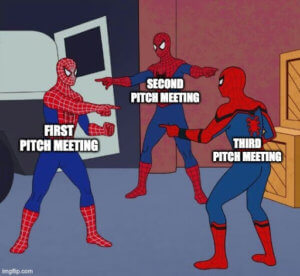Raising venture capital: The fundraising process, art of valuation, negotiation, and closing
Today we’re taking a no-nonsense approach to what the fundraising process looks like. We’ll keep it fun, we’ll keep it factual, and most importantly, we’ll keep it real. And with that in mind, it’s going to take a long time to close your fundraising round. Sure, maybe it won’t, maybe you’re an edge, but if you expect disappointment, you’ll never be disappointed. I usually prescribe 200+ first calls with VCs to get from open to close. This is typical for preseed-A. Especially in hardware, this is far more likely than your first couple of rounds going quickly; 200 might really be 400+. It’s just important to never get discouraged and to power through.

Image courtesy of Reddit
A typical process from intro to close
If you’re expecting a long process, here are the basic steps to outline, many of which you may go through with every VC (obviously lots of variation we’ll try to point out).
First pitch: Very similar to a first date, a first pitch is a get-to-know-you. If you’re operating on a good cadence, you and the investor exchange pleasantries and small talk for the first 5–10 minutes, you segue into your backstory, and from there segue into the problem you identified. They ask some basic investor questions about the market, costs, risks, etc., and you’re done in 30 minutes.
Sounds simple, right? Only complication is that you’re getting judged from the second you log on to the call. From how timely you are (or if you’re too early — can’t be too eager), to who you show up with (first calls should always just be the CEO), to how well you can hold a conversation about baseball, VCs want to know you understand the dance of fundraising. If you can connect with them, you can likely connect with other downstream investors, employees, and people you’re selling to. This is a personality test, and one you’ll complete time and time again.

50 first pitch meetings? More like 400. (Image courtesy of Columbia Pictures)
Second pitch: The second pitch is a lot like the first one, just with different people. If you started chatting with a partner, you’re likely looping in another partner. If you started with an associate, maybe a senior associate or a principal will join in. This cycle of looping in new people continues on for additional pitches until you’ve talked to every person who will make a decision on the deal. Once everyone has been introduced to the deal, then you can move forward. Note that new intro pitches may be gatekept based on the evaluations of the actual diligence.

Further diligence: Vague, but VCs can and will run you through the ringer of additional DD (due diligence). This can include, but certainly isn’t limited to:
- Technical DD: They might loop in technical experts or advisors to walk through the tech stack.
- Market DD: You may have to prove your market exists with customer intros, long calls, or anything in between. This happens frequently and shouldn’t come as a surprise.
- Requested personal references: You could be asked to provide 2–3 references. Doesn’t always happen, but you should be prepared for it.
- Underground personal references: Underground is a strong word, but VCs have their own networks, and they’ll check them. Don’t be surprised if people go barking up some interesting trees.
IC meeting: This is where the VCs have you present to the full team. You run through the same intro pitch and answer basic questions. Realistically, the decision will have likely been made by the time you make it to this stage. Your job is to show up, show well, and if there are partners on the fence, make sure you convert them. After this meeting, the VCs convene behind closed doors, debate, and reach a final decision.
Term sheet: If you get the green light, a VC will issue you a term sheet. Assuming you sign, that stops your conversations with any other potential leads. The term sheet can be very thorough or rather vague. The main goal is for it to set parameters for negotiating the closing docs.
Negotiation: Once you’ve signed a term sheet, the VC counsel and your lawyers start going back and forth on the closing docs. Usually the startup drafts these first and then the opposing counsel goes back and revises them. This process can continue for many cycles and can kill deals. I’ve personally had multiple deals blow up in the negotiation phase. It’s extremely important to have good legal counsel that you trust, and to read documents yourself and ask questions when there are aspects that you don’t understand. And if you’re doing well, never accept liquidation preferences.
Close: This is the last step; you circle the follow-on capital (see: people who don’t have the guts to write their own term sheet) and get that closed. Everyone signs off on the docs, and cash gets wired. You’re in business.
How VCs price your early-stage hardware startup

Once a VC wants to invest in your startup, there’s still one more question remaining: How much money will they give you at what price? And realistically, if you’re a hardware startup, these prices will be made up until you’re at a Series B (or in some cases even later). The reason for that is real revenue won’t start coming in the doors until post-A, but when it starts, it doesn’t stop. Sort of an “if you build it, they will come” mentality.
So when VCs underwrite valuations for hard tech, there’s a different determination: Do I want to give you money? And how much money do you actually need? A lot of people are a bit overly ambitious on their fundraising goals, and no, most startups don’t need $5MM at the seed. VCs will figure out the amount of money that you actually need and then use that to factor in 25–33% dilution (as much as possible without disincentivizing the founder). So if you’re raising $1MM, the implied valuation is roughly $3–4MM post-money.
The VC may adjust the round size so you’re raising less money. But instead of creating a value for the company, they assign a value to the amount of money you need. Messed up, but weirdly enough, it usually seems to work for everyone. This, of course, is a guideline more than a rule. Hot deals can get valuations with less than 10% dilution. Aggressive VCs can angle for majority control. But this is about what’s standard at the seed and the A.
No VC ever passes because of valuation; there’s a way to make every deal work. VCs use warrant structures, changed voting shares, board seats, and weird side letters to get things done. If they’re passing due to valuation (and without trying to make a different structure hit), odds are there’s something else going on.
You’ve found your lead, but now what?
Once you have a lead, the fun begins. Although it’s been harder to close this year than in years past, you get to complete the process of closing the round, filling with follow on investors, and trying to get the best deal. Once one person issues the term sheet, you’re safe. Now is when you have the power. You should complete the process by:
- Creating competitive deal dynamics (ideally, you’ll have multiple VCs chasing after you by this time, but if you have just one, your power decreases significantly)
- Running investor diligence with portfolio companies, especially companies that have done poorly
- Balancing follow-on investors by areas of expertise
- Validating value-add from your lead and other investors
- Celebrating — you’re almost there!
A note, though, on competitive deal dynamics: Don’t shop term sheets. VC is a small world, and we all know each other. Shopping term sheets is a bad look for you and can cause the original offer to get pulled. That doesn’t mean you shouldn’t try to get the best deal, but do that of your own merit, leverage time pressure, and discuss “hypothetical valuations” and “pending term sheets” instead of directly shopping.
And if you have an investor you like, and the valuation is about right, you should take the deal. No need to split hairs. If you’re at a seed and you’re debating between a $10MM and a $12MM valuation, although it is very tangible, consider that you’ll likely take 80% + dilution over the subsequent fundraising rounds. So say you’re raising $1MM and exiting for $1B; that 1.7% in ownership becomes 0.3%. And if you’re exiting for $1B, are you really going to sweat that extra $3M? The horrors! You only made $100MM not $103MM… versus the risk you put your startup in by not fundraising means you could have 0.
Now, I’ve seen rare instances where the valuation is about half or a third of what it should be. Even if you like the investor, you should reject that. Those differences become very significant. In short, though, every situation is different. Play out the risks, and optimize the expected value. Close quickly, with good people. Those are the best things you can do for your startup.
But what do you do if you need cash now? Realistically, you shouldn’t be raising venture capital.

Image courtesy of “Best Commercial Jingle”
If you’re in a tight bind with cash, realistically you shouldn’t be raising venture capital. See if you can find angel investors for a bridge round. Triangulate to break even while you can run a venture capital process. Find a way to take on venture debt or get non-dilutive funding. But VC is a long cycle, especially for hardware. If you need cash now, it’s probably too late to start.
Congratulations (it doesn’t get easier)!
You’ve done it! You finished fundraising! Or so you thought. The dirty secret about VCs and startups is that even once you’ve closed a round or a fund, you never stop fundraising. If you stop, you’re behind for the next fundraiser. The day you close one round is the day you start saying that to prospective leads for the next round. And starting to create the FOMO before it starts. So, you’re going to keep fundraising and taking meetings again and again and again until you either exit, liquidate, or raise one last pre-IPO round (at which point you still might have to fundraise when you’re public!). Strap in, we’re all in for a ride.
informal is a freelance collective for the most talented independent professionals in hardware and hardtech. Whether you’re looking for a single contractor, a full-time employee, or an entire team of professionals to work on everything from product development to go-to-market, informal has the perfect collection of people for the job.